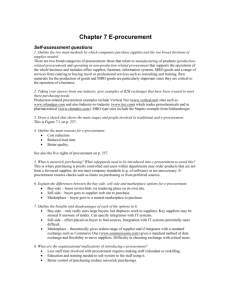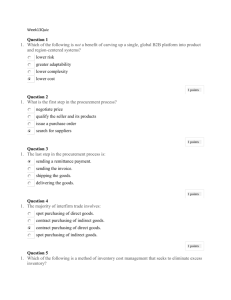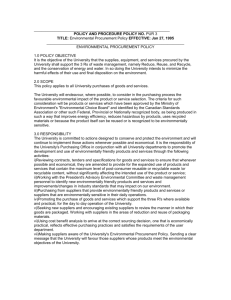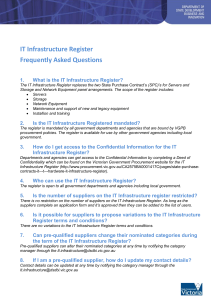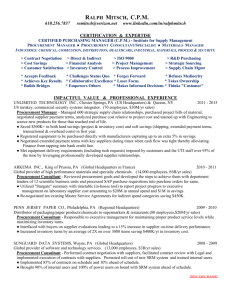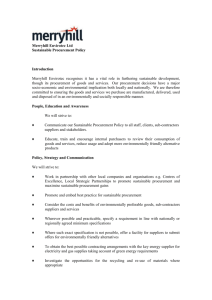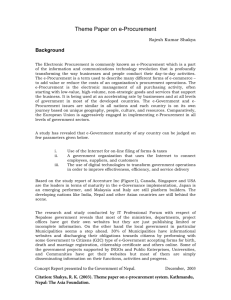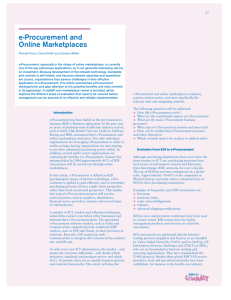Procurement - E
advertisement
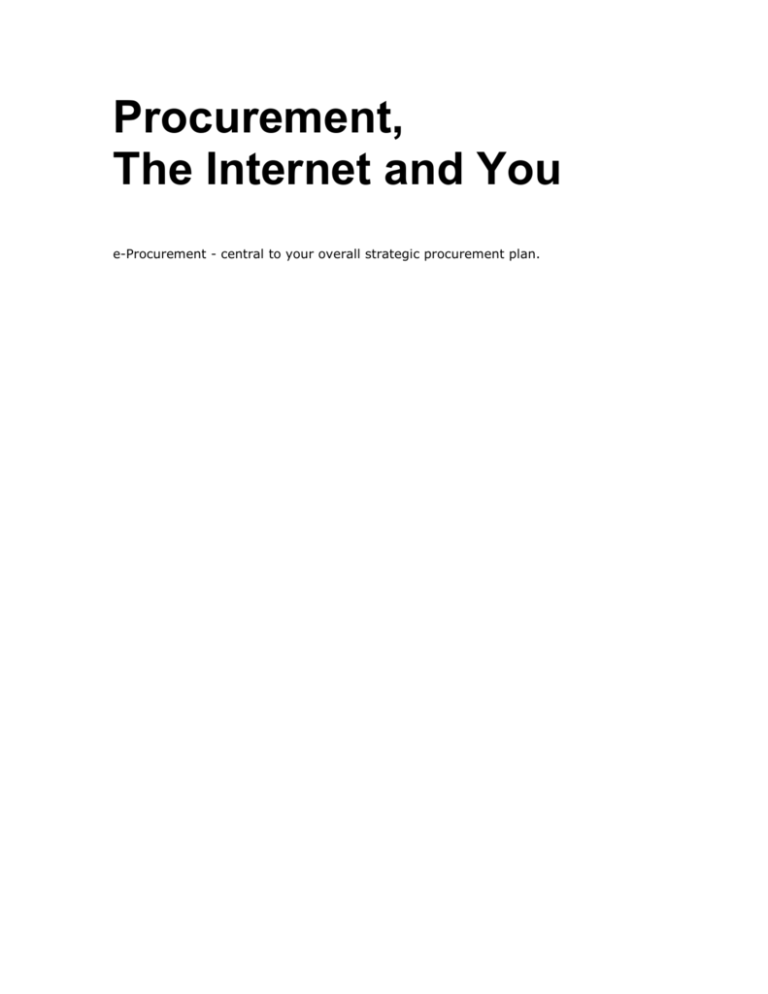
Procurement, The Internet and You e-Procurement - central to your overall strategic procurement plan. What is e-Procurement? e-Procurement - the purchase of goods or services through the internet - forms part of an overall strategic procurement plan. That plan may include strategic sourcing or supplier rationalisation, supply chain automation, and participation in one or more marketplaces. The commodities purchased can be operational resources (non production) or production resources (raw materials). An e-procurement solution typically contains functionality to automate searching for products and services, creating and submitting requisitions, online approvals, creating and transmitting purchase orders, supplying advanced shipping notices, invoicing and possibly payment processing. Operational resources (OR) are items such as travel, office supplies, contract labour, cleaning supplies and services. Although expenditure on OR varies by industry and organisation, on average these purchases account for 40% of purchasing spend. In some industries, such as service industries, the figure can be as high as 70%. Add the amount spent on production items, and a substantial portion of an organisation’s purchases can be automated using an e-procurement solution. And of course reducing purchasing expenditure directly benefits overall profitability. Case Study: State Govt streamlines spend An example of e-procurement at State Government level illustrates the potential impact of this e-marketplace tool. The Western Australia Government recently announced it is forming a Government Electronic Market (GEM) and estimates it may save more than £60 million per year by automating and streamlining its £3 billion spend on maintenance, repair and operation (MRO) items. The Govt calculates its current average cost per simple purchase transaction is £40-65. Following the GEM implementation, it predicts this cost to be reduced to £6. Tangible business benefits Business benefits achieved through successful e-procurement initiatives include cost reductions, improved information, increased efficiencies and the strategic use of purchasing staff. Cost Reductions Companies can realise significant reductions in both the cost of purchased items and the actual cost of processing a purchase order. By aggregating total purchases, contract pricing can be based on volume thresholds. This results in lower costs for individual items where larger volumes are purchased. Supporting this theory, the National Association of Purchasing Management (NAPM) estimates that companies pay 15-25% more for goods and services when an employee makes a purchase that does not leverage an existing contract. Through closer relationships with a smaller number of suppliers, better delivery terms can be negotiated with multiple orders consolidated into single deliveries. “Maverick purchasing” is reduced by limiting employee purchasing to a range of approved vendors, thereby controlling and reducing overall purchasing spend. Research by the Aberdeen Group estimates leakage (buying off contract) alone accounts for 30-40% of a company’s OR spend. Costs are reduced as end users can prepare their own orders for approved vendors at approved pricing levels with no interaction with the purchasing department. Approvals, when required, are routed electronically, reducing internal lead times. This also has the benefit of reducing errors by electronically transmitting data. Leveraging Information e-Procurement enables visibility of organisational purchasing data, creating the opportunity to negotiate better terms with suppliers based on volumes, price & quality. Similarly, supplier performance metrics for on-time shipments, quality and invoicing can be considered when negotiating terms with suppliers and determining sourcing strategies for items/categories of items. By analysing the purchasing history, organisations can calculate the total cost of ownership rather than just the purchase price. Information can also be leveraged by end users to track status, delivery and payment terms. This allows them to plan and manage order requirements. Storing and maintaining information in a central database of supplier catalogues and pricing information allows users to order against current pricing data and approved suppliers. Increased Efficiencies Workflow - from producing a purchase request through to payment - can be managed electronically by e-procurement processes, reducing errors and processing time. These efficiencies enable a reduced cycle time from requisition to payment. The Aberdeen Group estimates the time saved at 70%. These timesaving allowed reduced inventory levels, resulting in additional cost savings through better cash flow and lessened inventory carrying costs. Minimum order quantities and spending amounts can be set for users or departments enabling consolidation of multiple purchase requests. This has the benefit of reducing the total number of purchase orders, which in turn reduces processing costs. More strategic use of purchasing staff With e-procurement, purchasing staff is freed to focus on more strategic activities like analysis, selection, and negotiations with suppliers, and departmental buyer requirements. The business risks While e-business employs technology, it is primarily a business issue. Consequently, new initiatives require dedicated analysis and planning to minimise associated risks. A risk area often overlooked and under-estimated in e-business initiatives is the impact on people within, and people external to, the organisation. When the role of purchasing takes on strategic rather than tactical importance, organisational change ensues. If procurement has always been a lengthy, centralised process in an organisation, changing the process to enable desktop ordering by approved employees represents a significant change that needs to be managed. Training and support for purchasing staff with new responsibilities and end users is an important component in managing this change. In addition, senior management must show leadership and support the implementation of change by insisting on compliance. Outside of the organisation, awareness and stakeholder management issues assumes tremendous importance. Following e-procurement implementation, relationships with suppliers continue to increase in strategic importance. Managing supplier perceptions is critical as trust and common understanding in supplier relationships are essential for project success. Communication with suppliers should include project goals that reinforce the message that e-procurement is also designed to strengthen existing supplier relations. This encourages suppliers to view initiatives as opportunities rather than threats. Process review and improvement As e-business is a strategic business issue, many of its business benefits are achieved by changing and improving the business processes that support the procurement process. Changes to internal processes will extend outside organisational boundaries, impacting interactions with suppliers and customers. This presents an opportunity to strengthen relationships with suppliers to further drive efficiencies and increase the positive impact on organisations’ bottom lines. An e-procurement project should be undertaken as part of a total supply management strategy. The project is started by examining the current amount of suppliers and the amount spent with each. This information can be difficult to determine because the data may not be available or in a format conducive to comparison. This analysis will form the basis for rationalizing the number of suppliers and determining with whom to negotiate pricing and terms. It is also important to determine what organisations are trying to achieve and how success will be measured. Prior to purchasing a software package to automate the new process, organisations should determine their required functionality. They then can determine the best fit by knowing what questions to ask and testing several vendors. Organisations should then examine current processes, and take the opportunity to change and improve processes rather than just automate current ones. A thorough analysis will provide ample justification for taking the time to reengineer processes. The final key to improving processes is ensuring proper controls are put in place to minimise risk and ensure compliance is monitored. Technology solutions that fit Once the requirements analysis and process review are complete, organisations can determine the technological requirements for their project. Organisations should consider the cost versus the benefits of integration to existing systems. In doing so, it is important to know where the benefits are coming from, and what portions of the project will have the most impact on the organisation. Businesses should also determine the level of on-going support and total cost of all possible solutions. As data will be passed outside organisations’ systems and networks, it is critical to evaluate and minimise the risks associated with the complexities added to information system operations. Next Steps With media, analysts and vendors encouraging new e-business initiatives, there are essentially two options for organisations considering e-procurement: take a wait and see approach or begin now. Postponing implementation Adopting a wait and see attitude allows the market to mature and means suppliers will become more sophisticated. In time, software vendors will have more mature products. However, companies adopting this approach continue to pay high transaction costs, have no spending controls, and lose the current savings opportunity. e-Business initiatives and the Internet are fuelling the pace of globalisation. Technology is providing suppliers with easy, low cost access to the global marketplace. Competition is increasing and suppliers not taking positive measures to improve their operations, strengthen current relationships, and expand their customer base will find their existing markets increasingly threatened. Beginning now The risks of postponing initiatives must be balanced with competitive pressures in the marketplace and the opportunities for business improvement as demonstrated through real corporate examples. In an environment of global competition, all business, no matter what they produce, will have to embrace and master new and emerging technologies to survive. By immediately embracing e-procurement, organisations reduce and manage inventory holdings, cut lead times, eliminate damage and storage, significantly reduce warehouse costs and slash the time to market for innovation and process improvement. Achieving these benefits allows organisations to be more responsive to customers, drive down operating costs and working capital requirements and increase shareholder value. A planned approach to strategic procurement By taking a planned approach to strategic procurement, organisations can place themselves ahead of competitors adopting a wait and see approach. Those with an eye on the future consider e-procurement as a stepping-stone to additional corporate e-business opportunities. Analysts view procurement projects as involving the same strategies as fully web-enabled supply chains but on a smaller, more controllable level. As part of a strategic procurement plan, implementation of an e-procurement solution paves the way for supply chain automation and participation in electronic marketplaces. These additional e-business initiatives can improve relationships with suppliers and distributors, creating further efficiency gains. To achieve competitive advantage, organisations should consider leveraging a customisable e-procurement solution such as the BT e-Business Manager suite, in order to kick-start procurement savings and maximise business benefits. e-hub e-Business Solutions Enterprises have a wide variety of e-business needs for pursuing different market strategies and business models. e-hub solutions provide flexible, customisable functionality and industry best-practices to help different enterprises address their unique e-business needs effectively. Consisting of a modular set of feature-rich components, capable of customisation to create the best solution for you and your suppliers/customers, the solutions include: Procurement Solution The Procurement solution enables enterprises to significantly reduce procurement costs by streamlining and automating purchasing processes for goods and services. This solution helps you to integrate multiple suppliers, implement strategic sourcing, and leverage greater buying power, and strengthen key supplier relationships. Marketplace Solution The Marketplace solution enables enterprises to bring multiple suppliers and buyers together in a powerful online marketplace, offering a more efficient, cost-effective, and highly scalable way to conduct business transactions. Tenderhub Solution The Tenderhub solution offers awarding authorities a complete end-to-end tender management solution from building the tender document, publishing & administrating online notices, evaluating responses & generating the contract award to integration with a contracts management system. Procurement Solution Turn your purchasing operation into a powerful money-saving asset To remain leaders in today’s markets, enterprises have to improve value chain efficiencies and reduce operating costs as much as possible. The Procurement Solution enables enterprises to leverage their full buying power and realise the full potential of online procurement processes. Reduce purchasing costs Increased process efficiency leads to lower operational costs. Eliminate unregulated, unauthorised purchases. Consolidate product catalogues from multiple vendors into a single multi-vendor catalogue, and save time previously spent browsing multiple catalogues in different formats and filling out long order forms. Strengthen relationships with suppliers Enable your suppliers to easily participate in your procurement solution with powerful and easy-to-use features. Increase transparency by sharing product information and transactions in one environment while avoiding tedious external integration. Get the best price Consolidated multi-vendor catalogue makes it easy to compare prices. Centralised procurement gives you bargaining leverage for best prices. Improved visibility into your spending lets you consolidate purchases and suppliers to maximise volume discounts. Streamline authorisation workflow Set up business rules to create the right level of purchasing control based on employee or department. Improve budget control and cost centre management, achieve faster and more efficient order processing, and shorten inventory lead times. Integrate with existing systems The Procurement Solution provides seamless integration with existing systems and is designed to get you up and running fast, resulting in quick cost savings and process improvements. e-hub realises that your business needs will change over time. That’s why the Procurement Solution is designed to be customised easily and affordably by business users. Powerful Technology Procurement Solution features includes: Supplier catalogue mapping functionality for combining different catalogues Support for industry-standard catalogue formats Order splitting for more efficient order processing and fulfilment Comprehensive order tracking functionality Tendering features (RFQ, RFP) to obtain the best offers from suppliers Extended customisable reporting functionality Customisable approval workflow functionality based on budget groups Seamless backend integration to systems Marketplace Solution Online marketplaces provide substantial opportunities for enterprises to gain a competitive edge in their markets by enabling them to tightly integrate key buyers and sellers and streamline their supply chains. To take advantage of these opportunities you need a powerful e-procurement solution. The Marketplace Solution enables you to rapidly deploy a complete and fully integrated e-commerce solution for integrating multiple suppliers and buyers on a robust, feature-rich, online marketplace. Integrate multiple buyers and sellers on your marketplace Online marketplaces bring buyers and sellers together in an online trading community to facilitate doing business electronically. They can optimise the supply chain and eliminate numerous inefficiencies related to buyer and seller transactions. The Marketplace Solution enables you to: Easily deploy a marketplace Integrate multiple suppliers and buyers Leverage multiple marketplace revenue models Multiple auction models Authorisation workflow Order splitting Order status tracking Multiple supplier/buyer integration Advanced pricing with tax calculation Product comparison tool Enable buyers to publish requests Suppliers to submit their offers then engage in electronic negotiations In addition, the browser-based back office system for suppliers provides secure access to only their data while enabling them to easily maintain: Product prices Product categories Customer categories Order Status Information Tenderhub Solution Maintaining cost competitiveness is a concern for organisations across all industry sectors. On average, 60% of business expenditure is on non-personnel related goods and services. Utilisation of the procurement services available through e-Business Manager can deliver significant and measurable savings to purchasers through our unique tenderhub system. The online tendering system is currently used extensively by the Republic of Ireland public sector, producing significant costs savings. Tenderhub Solution features: Create, manage and transmit both OJEC and non-OJEC notices Use the fully integrated up-to-date CPV & NUTS codes Automatic validation of tender forms to EC Procurement Directives Instant publishing of the notice to OJEC or other specified tender site. Huge savings in advertising through reduction of newspaper ads. Create, manage and exchange pre-qualification supplier information Manages questionnaires, subjects, questions and their attributes such as weightings Buyers build select lists and suppliers maintain profiles online Buyers may prepare tender documentation using the in-built Doc Manager Suppliers may register for notification relating to Tenders posted in certain areas Suppliers may download Tender Documentation from any specified website Buyers & Suppliers may use Tender-specific Discussion Forum for clarifications Buyers can analyse & store tender responses online complete with audit trail Buyers can issue Contract Award Notice online Using e-hub as an Application Service Provider (ASP) Q: I am considering automating my purchasing processes via an ASP, but am struggling to come up with the budget to do so. How can I build a case for employing e-hub as an ASP? A: It is generally accepted that in order to make money, you must spend money. In the current economy, the question on executives’ minds is how to keep spending to a minimum and revenue at a maximum. And in the B2B space, the buzz is focused on e-procurement and how much it can save versus how much it costs. Recently a number of companies have found a happy medium in ASPs. A recent Aberdeen report, “e-Procurement: Finally Ready for Prime Time” attests to the savings organisations are garnering from e-procurement applications. Aberdeen research suggests that “automating procurement offers the greatest opportunity to improve processes, increase productivity and reduce costs across the supply chain”. This same report indicated that hosted solutions could be implemented 23% faster and at 60% lower cost. It makes perfect sense really; automating the procurement processes saves money, and with an ASP, you outsource the headaches and the overheads. Under the ASP model, applications and supporting hardware platform are hosted in an offsite data centre. Users can access this centre over a communications line and can be charged on a subscription basis. The ASP provides all the computing power, storage, and network infrastructure needed to deliver the applications, as well as the staff to manage the entire platform. It has been found that the benefits of outsourcing eprocurement included a low capital outlay, application management and ongoing support (including upgrades), no IT staff maintenance burdens and a rapid ROI. So why isn’t everyone running out to sign with an ASP? Misconceptions abound when it comes to hosted e-procurement: Perception: 50% of all ASPs will be extinct by the end of the year. Reality: IDC recently reported that the growth rate for ASPs exceeded expectations. Perception: ASPs don’t need to understand the applications they support. Reality: A new class of hosting companies specialising in certain verticals or software applications has emerged. They provide value-added services around these applications, and are picking up speed rapidly. Perception: e-Procurement is just a way to automate the spending process; it is not a complex application. Reality: The great thing about e-procurement software is that the company decides how far it will reach. It can include numerous catalogues and access to auction facilities and eMarketplaces. The applications can communicate with the accounts payable department and human resources, and purchasing cards can be added. These functions can be a burden on IT staffs of even the largest companies. With a hosted e-procurement solution, these functions and many more can be implemented quickly. Specialised hosting companies have the expertise to manage and deploy the solution and the experience to recommend functionality that will be beneficial to the organisation. Contact Us Any questions relating to this document should be addressed directly to Shane Mulholland e-Business Consultant e-hub T: +44 (0) 28 302 54872 F: +44 (0) 28 302 52060 Web: www.e-hub.com Email: shane@e-hub.com ____________________________________________ e-hub plc, First Derivatives House, Kilmorey Business Pk, Newry, BT34 2LU
